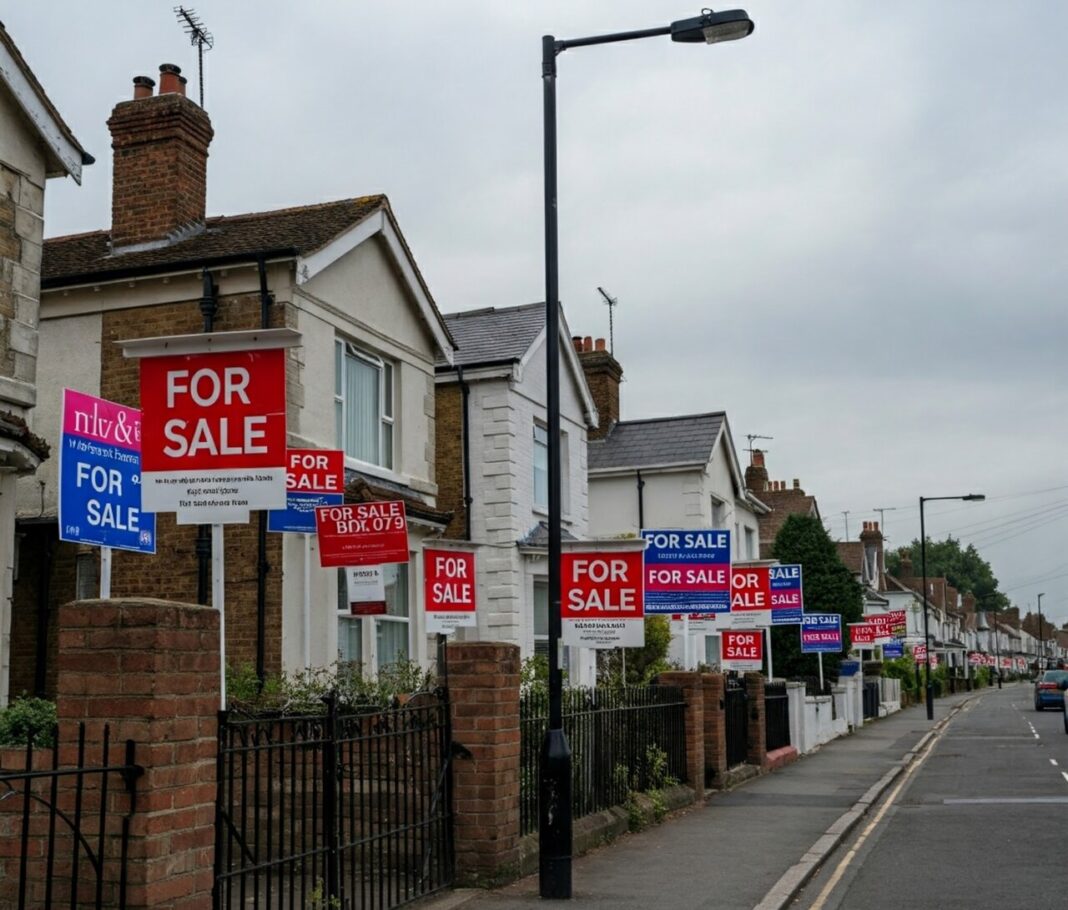New data from Nationwide has revealed that UK house price growth is continuing to slow, with the annual rate dropping to 4.1% in January from 4.7% in December 2024. Despite this, house prices edged up slightly month-on-month, increasing by 0.1%. The average home now costs £268,213.
And Robert Gardner, Nationwide’s Chief Economist, emphasises the mounting affordability challenges facing prospective buyers.
“The housing market continues to show resilience despite ongoing affordability pressures,” he says. “As we highlighted in our recent affordability report, while there has been a modest improvement over the last year, affordability remains stretched by historic standards.”
For the average UK earner looking to buy a first home with a 20% deposit, mortgage payments now equate to 36% of their take-home pay – well above the long-term average of 30%. Moreover, the first-time buyer house price-to-earnings ratio stands at 5.0, significantly higher than the historic average of 3.9.
DEPOSIT HURDLE

“The deposit hurdle remains high,” says Gardner. “The record increase in rents and the broader cost-of-living crisis have made it even harder for renters to save, exacerbating affordability challenges.”
FAMILY SUPPORT
Against this backdrop, a growing number of first-time buyers are turning to family and friends for financial assistance. Nationwide’s data shows that in 2023/24, around 40% of first-time buyers received help through gifts, loans, or inheritance to raise a deposit.
Despite these obstacles, homeownership rates have remained relatively stable.
The latest English Housing Survey from the Ministry of Housing, Communities & Local Government (MHCLG) shows that the homeownership rate held steady at 65% in 2024. There was a slight increase in the number of people with mortgages, while the majority of homeowners – around 55% – own their properties outright, reflecting demographic trends.
GENERATION GAME
Long-term trends highlight stark generational disparities in homeownership. Younger age groups remain well below their 2004 peaks, though there has been some improvement over the last decade.
Homeownership among those aged 25-34 has risen from 36% in 2014 to 45% in 2024, but it still lags behind the 59% recorded in 2004.
Meanwhile, outright homeownership has surged, with the number of households in England owning their homes outright increasing by 1.3 million in the past decade to reach 8.7 million. This is largely driven by demographic shifts, with the number of outright homeowners aged 65+ rising from 4.5 million to 5.4 million.
INDUSTRY REACTION

Nathan Emerson, Chief Executive of Propertymark, says: “Moving into 2025, it’s positive to see that house prices and mortgage lending remain resilient despite continued affordability pressures.
“Currently, it’s likely a lot of movement in the market is due to people wanting to push through with their purchases and sales before the stamp duty rises in England and Northern Ireland in April.
“However, one aspect helping maintain momentum in the marketplace is the fact that mortgage rates and financial pressures are slowly improving for those looking to make a move.
“Propertymark member agents have reported that new buyers registered per branch have on average increased year on year by 44%. Therefore, with demand rising, now is potentially a great time to consider putting your house on the market and taking advantage of current market conditions.”
BEHAVIOURAL SHIFT

Iain McKenzie, CEO of The Guild of Property Professionals, said: “A year-on-year comparison will favour 2025 over 2024, with the market starting on a more positive footing so far. An increase in the number of homes for sale has provided buyers with more choice, and the increased number of new buyers into the market has led to heightened activity.
“Momentum built up towards the end of last year has carried over into 2025, with market activity bolstered by a rush to complete transactions ahead of the impending stamp duty changes in April.
“When these stamp duty changes come into effect, we could see a shift in buyer behaviour, with purchasers potentially focusing on areas offering more homes within the new thresholds. Additionally, negotiation tactics may come into play, particularly for properties priced near the threshold.
“Mortgage rates are anticipated to decline marginally this year, although this will depend on a reduction in pressure on global market interest rates, alongside the Bank of England’s decision to cut the base rate. If forecasts are accurate, the first base rate cut could occur at the upcoming meeting on 6 February.
“Mortgage rates are expected to range between 4% and 5% during 2025. While rates remain slightly elevated, buyers are approaching the market with caution, making accurate pricing critical to maintaining momentum.”
STRONG START

Jason Tebb, President of OnTheMarket, says: “The housing market has got off to a strong start this year with the impending end of the stamp duty concession in March galvanising buyers and sellers.
“Two quarter-point base-rate reductions in the second half of last year, with the forecast of more to come, is certainly helping sentiment.
“Affordability concerns are an issue with rates higher than many borrowers have grown used to, along with the high cost of living and other pressures. Buyers, particularly those reliant on a mortgage, are more inclined to commit to a property purchase when they feel more confident about the outlook for rates.
“With property values not running away with themselves, buyers remain sensitive on price and won’t pay over the odds. Sellers keen to take advantage of this busier time of year must be realistic with regard to their pricing expectations.”
STAMP DUTY

Matt Thompson, head of sales at Chestertons, says: “In January, the property market saw particularly high demand from first-time buyers who were motivated to beat April’s stamp duty deadline.
“This spike in buyer activity led to the majority of properties exchange hands for the asking price although some sellers, especially those in a rush to sell, agreed to enter price negotiations.
“As there is still time to benefit from the current stamp duty threshold, we expect more first-time buyers to enter the market over the coming weeks.”
DOWNWARDS PRESSURE

Tom Bill, head of UK residential research at Knight Frank, said: “Higher borrowing costs are weighing on buyers but demand still feels artificially strong.
“Sub-4% mortgage offers that pre-date the Budget and an April rise in stamp duty means demand in the first quarter of the year is likely to be more robust than in the second.
“Until rate cut expectations improve and mortgages starting with a 3 re-appear, we expect further downwards pressure on house prices.”
PRICE GROWTH SOFTENING

Jeremy Leaf, north London estate agent and a former RICS residential chairman, says: “Price growth is softening, partly in response to a new year bounce in supply but also as the impact of the spike in first-time buyer demand prompted by April’s withdrawal of the stamp duty concession falls away.
“Looking forward, although wages have been outpacing inflation over recent times, which has helped to boost confidence, affordability concerns have never gone away.
“The market remains tight and little change is expected over the next few months at least, irrespective of any possible interest rate reductions.”
FIRST-TIME BUYER ADVANTAGE

Amy Reynolds, head of sales at Richmond estate agency Antony Roberts, says: “The first half of the month was a bit slow but it has turned out to be a busier January than normal.
“The stamp duty holiday has helped, with an increase in sales agreed in those chains where there is a first-time buyer keen to take advantage of the discount before the end of March. While this has been welcome, there is concern that one the stamp duty holiday ends, there will be a dip in activity and transactions.
“The value of a stamp duty incentive to first-time buyers is instant – it is real cash in their pockets, allowing someone to buy who otherwise might not be able to and this impacts those trying to move because they need a first-time buyer at the bottom of the chain in order for the second stepper to move on.
“It is the sale of larger homes that stimulates the economy and those higher value transactions brings in significant revenue. We would therefore urge the Government to reconsider and introduce much-needed further stamp duty concessions in the Spring statement.”
CHEAPER MORTGAGES

Mark Harris, chief executive of mortgage broker SPF Private Clients, says: “Since the start of the year, mortgage pricing has not seen the consistent downwards trend that borrowers would like. However, if Swap rates, which underpin the pricing of fixed-rate mortgages, continue to slide, it is hoped this will be passed onto borrowers in the form of cheaper mortgage rates in coming days and weeks.
“With the Bank of England expected to reduce interest rates next week, the outlook for borrowers is looking up. With some forecasters expecting a handful of rate reductions this year, it is encouraging news for those thinking of buying a property or refinancing.”
AFFORDABILITY ISSUES

Tomer Aboody, director of specialist lender MT Finance, says: “With Nationwide’s numbers further indicating a confident market, actual growth in prices is very minimal as buyers face a challenging period due to affordability.
“Although rates remain reasonable, many in the market were hoping for a further cut by now, and are hopeful it won’t be long before we get one.
“More flexibility is needed from lenders in order to help buyers onto the ladder, and many are questioning whether the Chancellor’s growth message is realistic as little help has been evident so far.”










